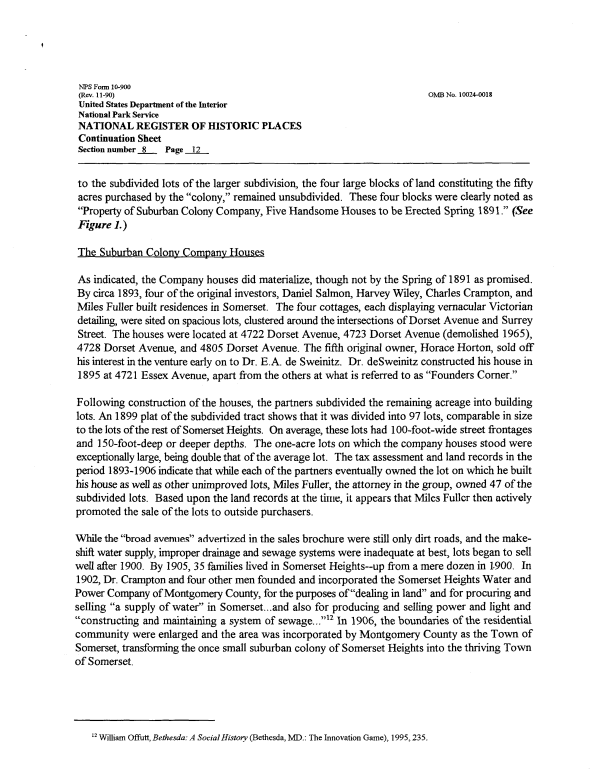 |
||||
|
DEPARTMENT OF HOUSING AND COMMUNITY DEVELOPMENT, MARYLAND HISTORICAL TRUST (Historic Sites Survey) var.d. MSA SE16-5 Image No: se16-5-0238 Enlarge and print image (72K) |
 |
||||
|
DEPARTMENT OF HOUSING AND COMMUNITY DEVELOPMENT, MARYLAND HISTORICAL TRUST (Historic Sites Survey) var.d. MSA SE16-5 Image No: se16-5-0238 Enlarge and print image (72K) |
| NFS Form 10-900 (Rev. 11-90) OMB No. 10024-0018 United States Department of the Interior National Park Service NATIONAL REGISTER OF HISTORIC PLACES Continuation Sheet Section number _8_ Page 12 to the subdivided lots of the larger subdivision, the four large blocks of land constituting the fifty acres purchased by the "colony," remained unsubdivided. These four blocks were clearly noted as "Property of Suburban Colony Company, Five Handsome Houses to be Erected Spring 1891." (See Figure 1.) The Suburban Colony Company Houses As indicated, the Company houses did materialize, though not by the Spring of 1891 as promised. By circa 1893, four of the original investors, Daniel Salmon, Harvey Wiley, Charles Crampton, and Miles Fuller built residences in Somerset. The four cottages, each displaying vernacular Victorian detailing, were sited on spacious lots, clustered around the intersections of Dorset Avenue and Surrey Street. The houses were located at 4722 Dorset Avenue, 4723 Dorset Avenue (demolished 1965), 4728 Dorset Avenue, and 4805 Dorset Avenue. The fifth original owner, Horace Horton, sold off his interest in the venture early on to Dr. E. A. de Sweinitz. Dr. deSweinitz constructed his house in 1895 at 4721 Essex Avenue, apart from the others at what is referred to as "Founders Corner." Following construction of the houses, the partners subdivided the remaining acreage into building lots. An 1899 plat of the subdivided tract shows that it was divided into 97 lots, comparable in size to the lots of the rest of Somerset Heights. On average, these lots had 100-foot-wide street frontages and 150-foot-deep or deeper depths. The one-acre lots on which the company houses stood were exceptionally large, being double that of the average lot. The tax assessment and land records in the period 1893-1906 indicate that while each of the partners eventually owned the lot on which he built his house as well as other unimproved lots, Miles Fuller, the attorney in the group, owned 47 of the subdivided lots. Based upon the land records at the time, it appears that Miles Fuller then actively promoted the sale of the lots to outside purchasers. While the "broad avenues" advertized in the sales brochure were still only dirt roads, and the makeshift water supply, improper drainage and sewage systems were inadequate at best, lots began to sell well after 1900. By 1905, 35 families lived in Somerset Heights~up from a mere dozen in 1900. In 1902, Dr. Crampton and four other men founded and incorporated the Somerset Heights Water and Power Company of Montgomery County, for the purposes of "dealing in land" and for procuring and selling "a supply of water" in Somerset...and also for producing and selling power and light and "constructing and maintaining a system of sewage..."12 In 1906, the boundaries of the residential community were enlarged and the area was incorporated by Montgomery County as the Town of Somerset, transforming the once small suburban colony of Somerset Heights into the thriving Town of Somerset. 12 William Offutt, Bethesda: A Social History (Bethesda, MD.: The Innovation Game), 1995.235. |